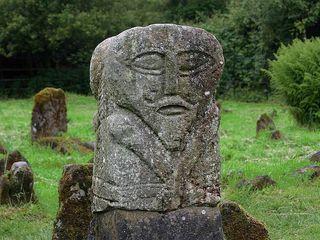Fear
Fear and Shame on New Year's Day
The two faces of Janus and how to get the new year off to a better start.
Posted January 1, 2016
As most people know, the “new year” has not always been celebrated on January 1st, and it is not fixed by any natural seasonal marker. Nonetheless, it is fixed in our psyche as a new beginning, and our focus is captured so well by the Roman god Janus – god of doorways and beginnings – for which this month is named.

Janus is depicted as having two faces. One looks back on the past, the other forward to the future. It’s a powerful image, isn’t it? If you’re listening to any sort of media today, you’ll see the parallel with commentators doing exactly the same thing, looking back on 2015 and forward to this new year.
Many, perhaps most, of us are doing the same thing. I think the biggest difference is that we may not be as analytical as the experts on radio, TV and social media outlets. My guess is that we move from quick recollections of the past year or glimpses of possibilities in the year ahead, and then our responses are primarily emotional. We feel more than we analyze.
What we feel is important, of course. For those who feel shame and regret looking back, or who feel fear and trepidation looking forward, we’re getting the new year off to a very bad start. These emotions are strongly associated with avoidance and disengagement. They undermine us before we even begin the new year. I think these emotions and our inability to manage them is why New Year’s resolutions are typically viewed as a joke. We’ll never succeed when we undermine ourselves from the outset.
What can we do differently? Well, I’m sure many contributors to the Psychology Today blog can offer a long list of strategies. I will offer only one today based on one of my favorite writers and educators, Parker Palmer.
In Palmer’s wonderful book The Courage to Teach, he writes about the culture of fear in which education is typically played out. Yet despite the disabling prevalence of fear, he writes
Each time I walk into a classroom, I can choose the place within myself from which my teaching will come, just as I can choose the place within my students toward which my teaching will be aimed. I need not teach from a fearful place: I can teach from curiosity or hope or empathy or honesty, places that are as real within me as are my fears. I can have fear, but I need not be fear—if I am willing to stand someplace else in my inner landscape.
“I can have fear, but I need not be fear–if I am willing to stand someplace else in my inner landscape.” This is a powerful message that I reflect on daily.
Today, on this first day of the new year and with Janus in mind, I stand in two places in my inner landscape. As I look back on 2015, I do so with gratitude. At the same time, as I look forward to 2016, I look forward with hope. These places of my inner landscape are as real within me as are my shame and fear which are certainly evoked when I look back and forward.
I may not choose whether or not shame and fear jump up at me in my reflections, for they do, and these emotions are quick and powerful. However, I can choose not “to be” these emotions today. I may have these emotions, but I choose not to be these emotions. There are other places in my inner landscape just as real, perhaps not as powerful, but just a real.
Gratitude and hope are what I choose on this important day of 2016. As I make this choice, I set the stage for a very good year ahead.


